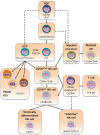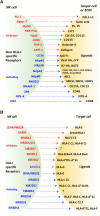Human NK cells, their receptors and function
- PMID: 33899224
- PMCID: PMC9292411
- DOI: 10.1002/eji.202049028
Human NK cells, their receptors and function
Abstract
NK cells are cytotoxic components of innate lymphoid cells (ILC) that provide a first line of defense against viral infections and contribute to control tumor growth and metastasis. Their function is finely regulated by an array of HLA-specific and non-HLA-specific inhibitory and activating receptors which allow to discriminate between healthy and altered cells. Human NK cells gained a major attention in recent years because of the important progresses in understanding their biology and of some promising data in tumor therapy. In this review, we will outline well-established issues of human NK cells and discuss some of the open questions, debates, and recent advances regarding their origin, differentiation, and tissue distribution. Newly defined NK cell specializations, including the impact of inhibitory checkpoints on their function, their crosstalk with other cell types, and the remarkable adaptive features acquired in response to certain virus infections will also be discussed.
Keywords: Adaptive NK cells; Human NK cells; Inhibitory checkpoints; NK cell receptors; TLR.
© 2021 The Authors. European Journal of Immunology published by Wiley-VCH GmbH.
Conflict of interest statement
All authors have provided intellectual contribution to the work and approved it for publication.
The authors declare no commercial or financial conflict of interest.
Figures



References
-
- Janeway, C. A., Jr. , Approaching the asymptote? Evolution and revolution in immunology. Cold Spring Harb. Symp. Quant. Biol. 1989. 54: 1–13. - PubMed
-
- Moretta, A. , Bottino, C. , Mingari, M. C. , Biassoni, R. and Moretta, L. , What is a natural killer cell? Nat. Immunol. 2002. 3: 6–8. - PubMed
-
- Schatz, D. G. and Swanson, P. C. , V(D)J recombination: mechanisms of initiation. Annu. Rev. Genet. 2011. 45: 167–202. - PubMed
-
- Banchereau, J. and Steinman, R. M. , Dendritic cells and the control of immunity. Nature 1998. 392: 245–252. - PubMed
-
- Moretta, A. , Bottino, C. , Vitale, M. , Pende, D. , Biassoni, R. , Mingari, M. C. and Moretta, L. , Receptors for HLA class‐I molecules in human natural killer cells. Annu. Rev. Immunol. 1996. 14: 619–648. - PubMed
Publication types
MeSH terms
LinkOut - more resources
Full Text Sources
Other Literature Sources
Research Materials

